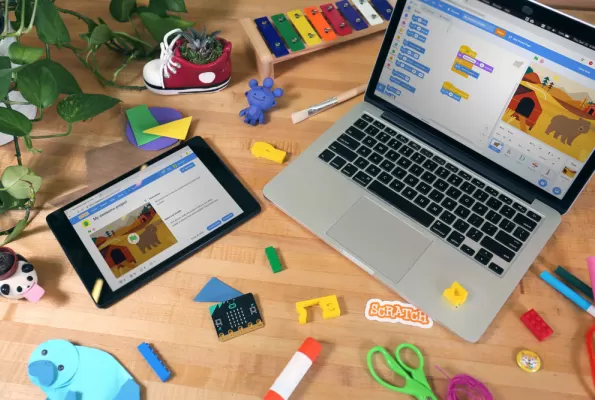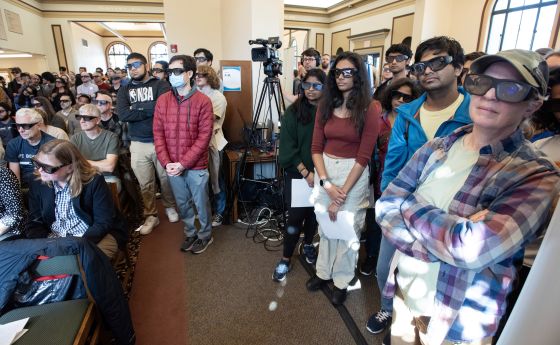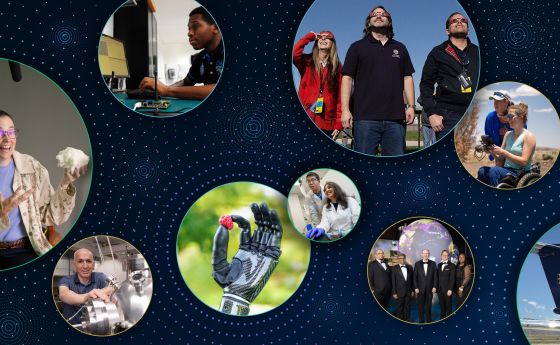
Seven NSF-supported STEM resources that are perfect for at-home learning
With schools across the country closing their doors to restrict the spread of the COVID-19 virus, nearly 30 million students in almost every state are facing disruption to their daily education. NSF has long supported innovative STEM education programs that supplement classroom learning and draw from existing best practices in education theory. Here are a few activities for learners of all ages that can be practiced at an appropriate social distance.
1. Learn to code using Scratch (ages 8-16) or ScratchJr (ages 5-7).
With Scratch, kids can program their own interactive stories, games and animations and share their creations with an online community. In the process, they develop software graphically as a way of learning the fundamentals of coding language. Launched in 2007, Scratch helps children improve their mathematics, computation and problem-solving skills.
2. Explore art and science through the Colors of Nature project (ages 11 and up).
Think science has nothing to do with art? Think again! Explore the creativity of science through a series of education kits that highlight how art and science work together to help us understand the world. The activities in the kits promote observation and the use of household items to explore color through the lens of chemistry, biology and optics.
3. Keep math skills sharp using GeoGebra (ages 13 and up).
GeoGebra is mathematics software for all levels of education that brings together geometry, algebra, spreadsheets, graphing, statistics and calculus in one easy-to-use package. To get started, check out the Learn how to use Resources page.
4. Get quality on- and off-screen through NSF-funded PBS shows (ages 3- 13)
Many of the NSF-funded science shows on PBS also have websites full of games and activities that allow kids to get creative and dive deeper into STEM concepts.
Peep and the Big Wide World -- one of the first STEM-focused shows for preschool-aged children -- has a parents page full of resources, such as how to organize a neighborhood safari, how to teach STEM concepts anywhere, and videos about how to help support your child's development and learning style.
Cyberchase has a 3D-builder math app and dozens of downloadable math and computing-based activities. SciGirls has interactive games on its kids' site, and resources for parents on how to encourage girls in STEM. Design Squad has videos and activities to engage children aged 10 to 13 in hands-on engineering.
With NOVA's Topic Earth, parents and children can explore a range of videos from "Ancient Arctic Animals" to "What it is Like to Live in Antarctica."
5. Become a citizen scientist and help collect and analyze data for scientific research (all ages).
People of all ages and backgrounds can help scientists do real research on everything from ants to astronomy. Find a project near you or online with the NSF-funded SciStarter website, which has more than 3,000 active projects, including the Earth Challenge 2020. The site offers projects to do while at the beach or in the car, and the search function allows you to filter by age group and by location type. Older kids might enjoy the NSF-funded documentary The Crowd and the Cloud, about the impact that technology-enabled citizen scientists are making in the world.
Zooniverse gives people of all ages and backgrounds the chance to participate in real research with more than 50 active online citizen science projects in many fields across the sciences, humanities, and more. Participants can engage in research of all kinds, from counting penguins to transcribing manuscripts to classifying galaxies, such as the volunteers who helped researchers discover a new type of galaxy – the Pea Galaxy (named after its small size and greenish color).
6. Use on-the-go science tools to explore the world around you (all ages)
Developed by an NSF-funded researcher, Foldscopes are paper microscopes that give you a deeper look at the world around you. Peer at the cell structure in an onion's skin, examine a human hair or look at the busy microbial world of pond scum.
Whether you are a teacher, student or other STEM enthusiast, NSF-supported Apps for your mobile devices will ignite your imagination. You can spend hours exploring the depths of the ocean; identifying fossils near you; or studying unimaginably beautiful insects. The NSF's Science Zone app allows you to navigate hundreds of exciting videos and high-resolution photos from a wide array of science topics.
7. Discover the mind-blowing science breakthroughs you may have missed in NSF's 4 Awesome Discoveries You Probably Didn't Hear About! (ages 13 and up)
From odd-looking animals to singing robots, some of the most incredible news never makes it to the front page. Exploring the top stories in science and tech, 4 Awesome Discoveries translates the latest breakthroughs into a series of fast-paced, engaging videos.
If you want even more STEM learning resources, check out our Twitter and Facebook accounts, which will be sharing tips, ideas and resources for fun and educational activities you can do at home.
“The pages and documents posted on this site include links to information created by other public and private organizations. These links are provided for the user's convenience. NSF does not control or guarantee the accuracy, relevance, timeliness, or completeness of this non-NSF information. The inclusion of these links is not intended to reflect their importance, nor is it intended to endorse views expressed, or products or services offered, on these non-NSF sites.”
COVID-19 Resources: Coronavirus.gov; Coronavirus Disease 2019 (COVID-19); What the U.S. Government is Doing





